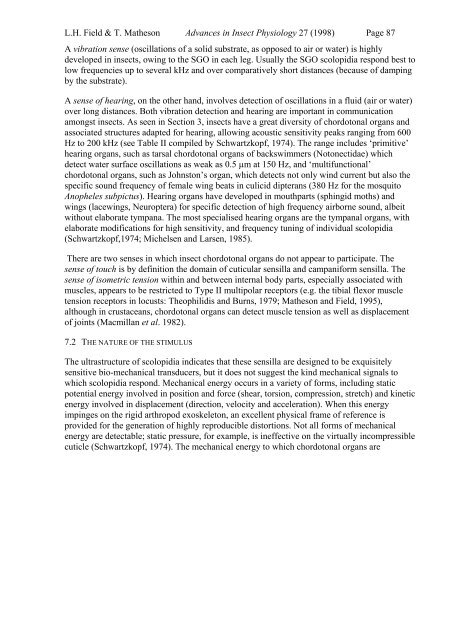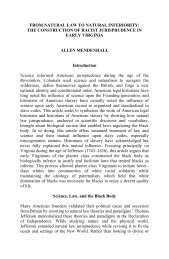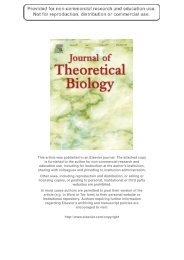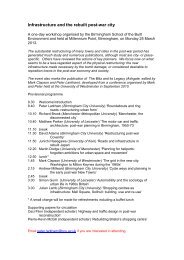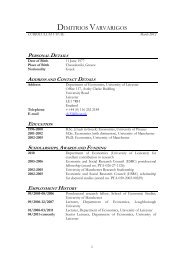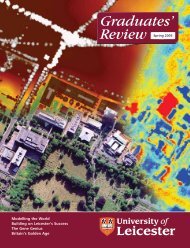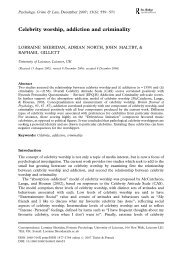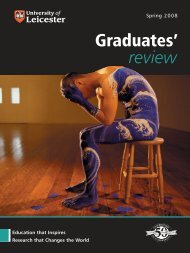Chordotonal Organs of Insects
Chordotonal Organs of Insects
Chordotonal Organs of Insects
Create successful ePaper yourself
Turn your PDF publications into a flip-book with our unique Google optimized e-Paper software.
L.H. Field & T. Matheson Advances in Insect Physiology 27 (1998) Page 87A vibration sense (oscillations <strong>of</strong> a solid substrate, as opposed to air or water) is highlydeveloped in insects, owing to the SGO in each leg. Usually the SGO scolopidia respond best tolow frequencies up to several kHz and over comparatively short distances (because <strong>of</strong> dampingby the substrate).A sense <strong>of</strong> hearing, on the other hand, involves detection <strong>of</strong> oscillations in a fluid (air or water)over long distances. Both vibration detection and hearing are important in communicationamongst insects. As seen in Section 3, insects have a great diversity <strong>of</strong> chordotonal organs andassociated structures adapted for hearing, allowing acoustic sensitivity peaks ranging from 600Hz to 200 kHz (see Table II compiled by Schwartzkopf, 1974). The range includes ‘primitive’hearing organs, such as tarsal chordotonal organs <strong>of</strong> backswimmers (Notonectidae) whichdetect water surface oscillations as weak as 0.5 µm at 150 Hz, and ‘multifunctional’chordotonal organs, such as Johnston’s organ, which detects not only wind current but also thespecific sound frequency <strong>of</strong> female wing beats in culicid dipterans (380 Hz for the mosquitoAnopheles subpictus). Hearing organs have developed in mouthparts (sphingid moths) andwings (lacewings, Neuroptera) for specific detection <strong>of</strong> high frequency airborne sound, albeitwithout elaborate tympana. The most specialised hearing organs are the tympanal organs, withelaborate modifications for high sensitivity, and frequency tuning <strong>of</strong> individual scolopidia(Schwartzkopf,1974; Michelsen and Larsen, 1985).There are two senses in which insect chordotonal organs do not appear to participate. Thesense <strong>of</strong> touch is by definition the domain <strong>of</strong> cuticular sensilla and campaniform sensilla. Thesense <strong>of</strong> isometric tension within and between internal body parts, especially associated withmuscles, appears to be restricted to Type II multipolar receptors (e.g. the tibial flexor muscletension receptors in locusts: Theophilidis and Burns, 1979; Matheson and Field, 1995),although in crustaceans, chordotonal organs can detect muscle tension as well as displacement<strong>of</strong> joints (Macmillan et al. 1982).7.2 THE NATURE OF THE STIMULUSThe ultrastructure <strong>of</strong> scolopidia indicates that these sensilla are designed to be exquisitelysensitive bio-mechanical transducers, but it does not suggest the kind mechanical signals towhich scolopidia respond. Mechanical energy occurs in a variety <strong>of</strong> forms, including staticpotential energy involved in position and force (shear, torsion, compression, stretch) and kineticenergy involved in displacement (direction, velocity and acceleration). When this energyimpinges on the rigid arthropod exoskeleton, an excellent physical frame <strong>of</strong> reference isprovided for the generation <strong>of</strong> highly reproducible distortions. Not all forms <strong>of</strong> mechanicalenergy are detectable; static pressure, for example, is ineffective on the virtually incompressiblecuticle (Schwartzkopf, 1974). The mechanical energy to which chordotonal organs are


